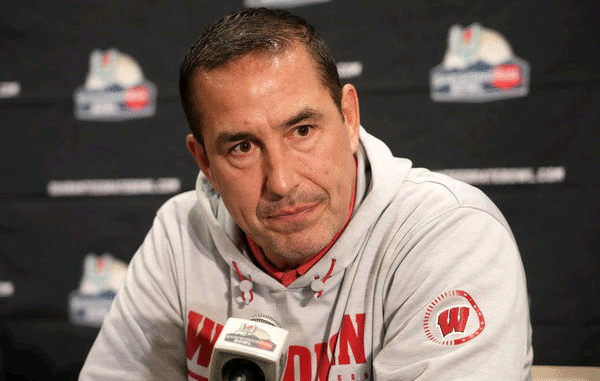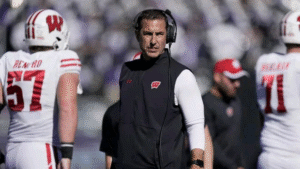
Wisconsin Badgers Fall Camp 2025: A Deep Dive into Offensive Line Battles, Young Talent, and New Philosophies
As the air turns cooler and the leaves begin to change, the excitement of football is once again taking center stage in Madison. The Wisconsin Badgers are back in action, with fall camp well underway. The football program is entering a pivotal moment, one filled with renewed energy, talent evaluations, and a strategic vision that could reshape the team’s identity heading into the 2025 season. This edition of Talkin’ Badgers digs deep into the latest updates, with particular focus on the evolving situation along the offensive line, the rise of promising young talent, and how a unified coaching philosophy may signal a new era in Badgers football.

The Left Tackle Situation: A Spotlight on Davis Heinzen
A major storyline developing from Wisconsin’s fall camp is the ongoing reshuffling of the offensive line—especially at left tackle. Throughout the spring, there was speculation and concern about how the team would handle the unexpected injury to Kevin Heywood, who had previously been a front-runner for the role. With Heywood sidelined, questions mounted around who would step up and fill this critical position.
Enter Davis Heinzen.
The transfer from Central Michigan has made a strong impression early in camp. He’s been working with the first-team unit, and all signs suggest he may have solidified himself as the new starting left tackle. Heinzen’s emergence is more than just filling a gap; it’s a testament to Wisconsin’s ability to adapt and find solutions internally rather than scrambling for emergency replacements. But what makes Heinzen such a viable candidate?
He brings both experience and maturity from his time at Central Michigan. At 6-foot-6 and over 300 pounds, Heinzen is built for Big Ten trench warfare. He possesses solid footwork, a strong base, and above-average athleticism for his size, allowing him to perform effectively in both run blocking and pass protection. The coaching staff has praised his fast adjustment to the Badgers’ system, and his chemistry with the rest of the offensive line is growing steadily.
But more than individual performance, Heinzen’s presence symbolizes stability. With a consistent left tackle, the offense can operate with more predictability. Quarterbacks feel safer in the pocket, running backs trust their lanes, and play-callers have more freedom to design aggressive schemes. In a conference known for physical play, Heinzen’s emergence is welcome news.
Luke Fickell’s Philosophy: Developing Talent Starts in the Trenches
Head coach Luke Fickell, now further settling into his leadership role at Wisconsin, has made one thing clear: success starts with the big guys up front. While offensive fireworks and explosive plays may generate headlines, Fickell has long believed that true football dominance is built in the trenches.
“You got to look at those big guys,” Fickell remarked during a recent media session. “That’s where our foundation lies. If we want to develop this program the right way, our offensive and defensive lines have to set the tone.”
Fickell’s coaching record backs up that philosophy. Known for his time at Cincinnati, where he developed numerous NFL-caliber linemen, Fickell now turns his attention to replicating that model in Madison. This year’s offensive line is more than just a physical unit—they are the embodiment of the team’s philosophy. They must be technically sound, tough, and relentless. In camp, Fickell has spent considerable time observing line drills, offering direct feedback, and encouraging a next-man-up mentality.
That mindset will be crucial as the Badgers continue to build around youth and navigate injuries. Wisconsin’s offensive identity is once again being sculpted to reflect physical control and precision in the trenches, and the results from camp indicate things are trending in the right direction.
Rising Stars and Youth Movement: Who’s Making Noise?
Fall camp is also an opportunity for the next generation of Badgers to make their mark. With every practice rep and every scrimmage, young players are stepping forward to prove they deserve a role in the 2025 campaign. Kedrick Stumbris, host of Talkin’ Badgers, dedicated a significant portion of his latest episode to highlighting these breakout talents.
Several true freshmen and second-year players have emerged as early standouts. Their names may not yet be familiar to most fans, but their performances are forcing coaches to take notice.
1. Jack Sorenson (Freshman Guard)
Recruited as part of the 2025 incoming class, Sorenson has impressed coaches with his advanced technique and physicality. While most first-year linemen need time to develop, Sorenson is already seeing snaps with the second unit. His ability to anchor against upperclassmen and create leverage at the point of attack makes him a candidate for a backup role this season—with the potential for a starting job down the line.
2. Miles Carter (Sophomore Center)
After a developmental freshman season, Carter has bulked up and added agility to his game. He’s pushing hard for rotational reps and could be in line to take over in the middle of the line if injuries occur. Coaches love his football IQ and leadership qualities—both essential for a center.
3. Kahlil Branch (Freshman Tackle)
While still raw, Branch’s athletic ceiling is undeniable. He’s incredibly agile for his size and has the kind of frame that could translate into elite-level tackle play with more experience. Coaches are bringing him along slowly, but there’s excitement about his long-term potential.
These players, among others, are creating healthy competition in the locker room. Their development is critical, not just for depth in 2025, but for shaping Wisconsin’s future core. The old model of relying solely on upperclassmen is shifting, as Fickell’s staff shows a willingness to trust younger players in meaningful roles.
Jeff Grimes and the New Offensive Identity
The hiring of offensive coordinator Jeff Grimes marked a turning point for Wisconsin. After years of trying to merge old-school Badger power football with modern spread elements—sometimes with underwhelming results—the program appears to have finally found philosophical harmony.
Grimes brings with him a track record of innovation mixed with physicality. His offenses at Baylor and BYU were known for balancing multiple run concepts with tempo-based passing attacks. But the key to his success has always been leaning on the offensive line.
“We have to build our identity around the guys up front,” Grimes recently noted. “Our scheme is going to give them the opportunity to dominate the line of scrimmage and wear teams down.”
This year’s offense will look to do exactly that.
Expect to see more zone runs, pulling guards, and play-action passes that make use of the quarterback’s mobility. Grimes has also installed more flexibility into the system, allowing the offense to adjust to defensive looks on the fly. That shift is helping players play faster and more decisively.
Stumbris discussed in detail how this philosophical unity between Grimes and Fickell is perhaps the most important development for Wisconsin in years. No longer are there competing offensive ideologies clashing behind the scenes. Now, players and coaches are rowing in the same direction—and that cohesion could unlock a higher ceiling than the program has seen in some time.
How It All Comes Together: The Bigger Picture
With fall camp reaching its halfway point, the pieces are beginning to fall into place for the Wisconsin Badgers. The offensive line, once a point of concern due to injuries and transition, is stabilizing. The emergence of Davis Heinzen as a steady presence at left tackle offers a significant boost. Meanwhile, the infusion of young talent is creating depth and fueling internal competition—a sign of a healthy program.
Just as importantly, the coaching staff is united behind a clear identity: build from the line out, empower young players early, and implement an offense that capitalizes on the strength of the unit. With Fickell’s vision and Grimes’ system aligning, Madison is poised for a new chapter in its storied football tradition.
The fans, analysts, and players alike can feel the momentum building.
As Kedrick Stumbris eloquently put it during the latest Talkin’ Badgers episode: “There’s something different this year. It’s not just about hope—it’s about direction. And finally, everyone in this program is pulling in the same direction.”
That kind of cohesion, along with emerging talent and tactical clarity, could make all the difference as Wisconsin heads into the 2025 season. While challenges remain—depth concerns, a grueling Big Ten schedule, and developing quarterback chemistry—the foundational progress being made in camp offers reasons for genuine optimism.
Final Thoughts: Why the Offensive Line Holds the Key
The offensive line may not get the spotlight like skill players or quarterbacks, but in Madison, it’s once again the backbone of the program. The left tackle question seems to have an answer. The young talent pipeline is stronger than it’s been in years. And the system now in place is tailor-made to leverage Wisconsin’s traditional strengths while incorporating modern wrinkles.
The team isn’t just preparing for the upcoming season—it’s rebuilding its identity, reconnecting with its roots while embracing a new football future. Fall camp has provided a glimpse into that transformation, and the energy surrounding the program is palpable.
As fans gear up for kickoff, they can take comfort in knowing that the program’s most important battles are being fought—and won—long before the first snap of the season.
Leave a Reply